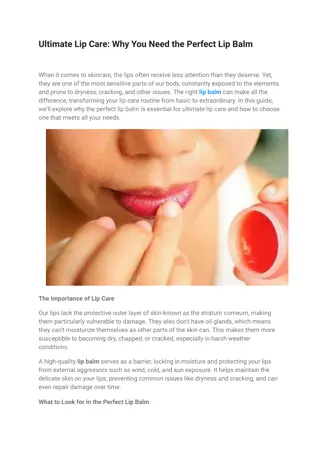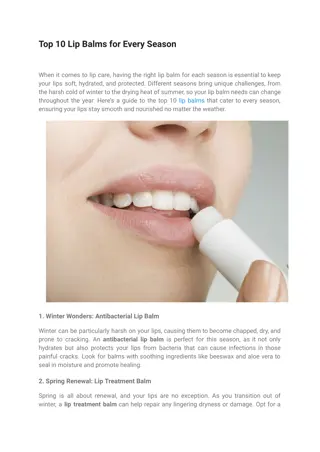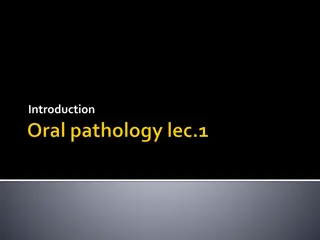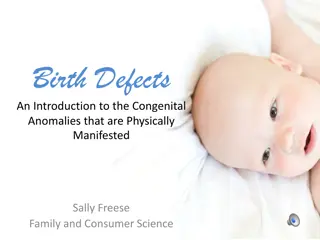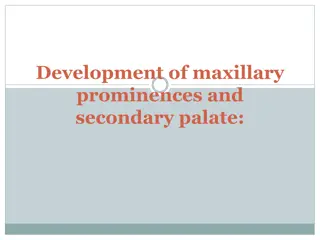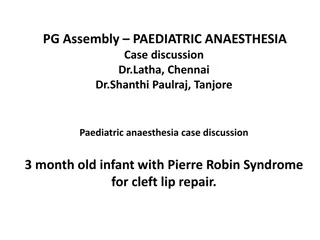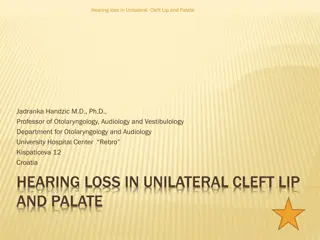
Understanding Cleft Lip and Palate in Babies
Learn about cleft lip and palate, common birth defects where facial structures don't close completely, causing openings. Discover symptoms, causes, treatment options, and more to help you understand and manage this condition effectively.
Download Presentation

Please find below an Image/Link to download the presentation.
The content on the website is provided AS IS for your information and personal use only. It may not be sold, licensed, or shared on other websites without obtaining consent from the author. If you encounter any issues during the download, it is possible that the publisher has removed the file from their server.
You are allowed to download the files provided on this website for personal or commercial use, subject to the condition that they are used lawfully. All files are the property of their respective owners.
The content on the website is provided AS IS for your information and personal use only. It may not be sold, licensed, or shared on other websites without obtaining consent from the author.
E N D
Presentation Transcript
StudyMafia.Org Cleft Lip And Cleft Palate Submitted To: Studymafia.org Submitted By: Studymafia.org
Table Contents Definition Introduction Symptoms of Cleft lip and Cleft Palate When to see a Doctor Causes of Cleft lip and Cleft Palate Risk-Factors of Cleft lip and Cleft Palate Complications of Cleft lip and Cleft Palate Prevention of Cleft lip and Cleft Palate Diagnosis of Cleft lip and Cleft Palate Treatment of Cleft lip and Cleft Palate Conclusion 2
Definition Cleft lip and cleft palate are openings or splits in the upper lip, the roof of the mouth (palate) or both. Cleft lip and cleft palate result when facial structures that are developing in an unborn baby don't close completely. 3
Introduction Cleft lip and cleft palate are among the most common birth defects. They most commonly occur as isolated birth defects but are also associated with many inherited genetic conditions or syndromes. Having a baby born with a cleft can be upsetting, but cleft lip and cleft palate can be corrected. In most babies, a series of surgeries can restore normal function and achieve a more normal appearance with minimal scarring. 4
When to see a doctor A cleft lip and cleft palate are usually noticed at birth, and your doctor may start coordinating care at that time. If your baby has signs and symptoms of a submucous cleft palate, make an appointment with your child's doctor. 6
Causes of Cleft lip and Cleft Palate Cleft lip and cleft palate occur when tissues in the baby's face and mouth don't fuse properly. Normally, the tissues that make up the lip and palate fuse together in the second and third months of pregnancy. But in babies with cleft lip and cleft palate, the fusion never takes place or occurs only part way, leaving an opening (cleft). Researchers believe that most cases of cleft lip and cleft palate are caused by an interaction of genetic and environmental factors. 7
Causes of Cleft lip and Cleft Palate In many babies, a definite cause isn't discovered. The mother or the father can pass on genes that cause clefting, either alone or as part of a genetic syndrome that includes a cleft lip or cleft palate as one of its signs. In some cases, babies inherit a gene that makes them more likely to develop a cleft, and then an environmental trigger actually causes the cleft to occur. 8
Risk factors of Cleft lip and Cleft Palate Several factors may increase the likelihood of a baby developing a cleft lip and cleft palate, including: Family history. Parents with a family history of cleft lip or cleft palate face a higher risk of having a baby with a cleft. Exposure to certain substances during pregnancy. Cleft lip and cleft palate may be more likely to occur in pregnant women who smoke cigarettes, drink alcohol or take certain medications. 9
Risk factors of Cleft lip and Cleft Palate Having diabetes. There is some evidence that women diagnosed with diabetes before pregnancy may have an increased risk of having a baby with a cleft lip with or without a cleft palate. Being obese during pregnancy. There is some evidence that babies born to obese women may have increased risk of cleft lip and palate. Males are more likely to have a cleft lip with or without cleft palate. Cleft palate without cleft lip is more common in females 10
Complications of Cleft lip and Cleft Palate Children with cleft lip with or without cleft palate face a variety of challenges, depending on the type and severity of the cleft. Difficulty feeding. One of the most immediate concerns after birth is feeding. While most babies with cleft lip can breast-feed, a cleft palate may make sucking difficult. Ear infections and hearing loss. Babies with cleft palate are especially at risk of developing middle ear fluid and hearing loss. 11
Complications of Cleft lip and Cleft Palate Dental problems. If the cleft extends through the upper gum, tooth development may be affected. Speech difficulties. Because the palate is used in forming sounds, the development of normal speech can be affected by a cleft palate. Speech may sound too nasal. Challenges of coping with a medical condition. Children with clefts may face social, emotional and behavioral problems due to differences in appearance and the stress of intensive medical care. 12
Prevention of Cleft lip and Cleft Palate After a baby is born with a cleft, parents are understandably concerned about the possibility of having another child with the same condition. While many cases of cleft lip and cleft palate can't be prevented, consider these steps to increase your understanding or lower your risk: Consider genetic counseling. If you have a family history of cleft lip and cleft palate, tell your doctor before you become pregnant. 13
Prevention of Cleft lip and Cleft Palate Take prenatal vitamins. If you're planning to get pregnant soon, ask your doctor if you should take prenatal vitamins. Don't use tobacco or alcohol. Use of alcohol or tobacco during pregnancy increases the risk of having a baby with a birth defect. 14
Diagnosis of Cleft lip and Cleft Palate Most cases of cleft lip and cleft palate are noticed right away at birth and don't require special tests for diagnosis. Increasingly, cleft lip and cleft palate are seen on ultrasound before the baby is born. Ultrasound before birth A prenatal ultrasound is a test that uses sound waves to create pictures of the developing fetus. When analyzing the pictures, a doctor may detect a difference in the facial structures. 15
Diagnosis of Cleft lip and Cleft Palate Cleft lip may be detected with ultrasound beginning around the 13th week of pregnancy. As the fetus continues developing, it may be easier to accurately diagnose a cleft lip. Cleft palate that occurs alone is more difficult to see using ultrasound. If prenatal ultrasound shows a cleft, your doctor may offer a procedure to take a sample of amniotic fluid from your uterus (amniocentesis). 16
Treatment of Cleft lip and Cleft Palate Care for children with cleft lip and cleft palate often involves a team of doctors and experts, including: Surgeons who specialize in cleft repair, such as plastic surgeons or ENTs Oral surgeons Ear, nose and throat doctors (ENTs, also called otorhinolaryngologists) Pediatricians 17
Treatment of Cleft lip and Cleft Palate Pediatric dentists Orthodontists Nurses Auditory or hearing specialists Speech therapists Genetic counselors Social workers Psychologists 18
Treatment of Cleft lip and Cleft Palate Feeding strategies, such as using a special bottle nipple or feeder Speech therapy to correct difficulty with speaking Orthodontic adjustments to the teeth and bite, such as having braces Monitoring by a pediatric dentist for tooth development and oral health from an early age 19
Treatment of Cleft lip and Cleft Palate Monitoring and treatment for ear infections, which may include ear tubes Hearing aids or other assistive devices for a child with hearing loss Therapy with a psychologist to help the child cope with the stress of repeated medical procedures or other concerns 20
Conclusion Combined cleft lip and palate was the commonest cleft deformity. Most patients were one year or younger. Millard's techniques with primary rhinoplasty provided acceptable aesthetic and functional result. Adequate pre- surgical preparation is a requirement for successful cleft palate repair. 21
References Google.com Wikipedia.org Studymafia.org Slidespanda.com
Thanks To StudyMafia.org







